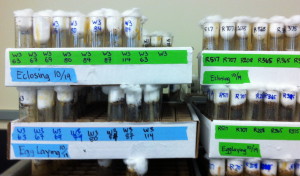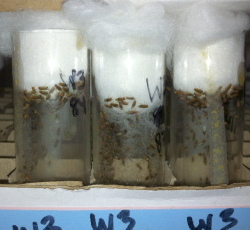Joint projects in fruitfly genomics
Summer 2012 – present
Sergey Nuzhdin, Professor of Biological Sciences, University of Southern California
Postdoctoral Associates:
Daniel Campo Falgueras
Matthew Salomon
Undergraduate Principal Investigators:
Jessica Gabrielian
Mishan Rambukwella
Clara V. Vu
High School Research Assistants (Summer 2012):
Chaten Ambastha
Nate Christian
Ana Gabrielian
Stanley Kim
The principal investigators on these projects are undergraduates at the University of Southern California. The projects were initially funded by the Summer Undergraduate Research Fund (SURF) at USC's Dornsife College of Letters, Arts and Sciences.
Jessica Gabrielian: Drosophila melanogaster resistance to the fungal pathogen Beauveria bassiana

The project I will be working on throughout the summer is based on the resistance of Drosophila populations to fungal pathogens. Insect pathogens are used as controls for the reduction of insect spread diseases. The further analysis of fungal resistance in Drosophila melanogaster can lead to the possible discovery of specific genes that allow for higher resistances to fungal pathogens. With the knowledge of possible genes correlated to fungal resistance, pathogens can be developed to avoid resistances and allow proper control of insects carrying disease. The aim of this project is to locate regions of the genome correlated with resistance to fungal pathogens.
Previous research with the fungus Beauveria bassiana and its use for the infection of D. melanogaster has demonstrated variation in resistance among genotypes within a population and between populations from different geographic regions [1]. The same research showed higher resistances in fruit flies from tropical regions than those from temperate regions [1]. Nevertheless, there was no further analysis on the underlying genes that might be correlated with resistance of the fungal pathogen.
With the leadership of two postdocs, Daniel Campo and Matthew Salomon, I will be assaying the susceptibility to infection of D. melanogaster from three geographical regions with the fungal pathogen Beauveria bassiana. The populations which are currently available within the lab come from Winters (CA), Raleigh (NC), and different locations within the Caribbean region. The entire genome sequences of the fruit flies from the North American regions are already available and the flies from the Caribbean are currently being sequenced. The assay will collect data of the mortality/survivorship rates from the different lines (genotypes) of D. melanogaster and will demonstrate variation between lines if present. We can then group the flies according to resistance level and perform a genome-wide association study to try to find genes that are potentially involved in fungal resistance. Furthermore, we will check if there is a correlation between the geographical origin of the flies and their level of resistance.
Throughout the assay, flies from different lines will be collected and stored for future studies. RNA will be extracted from the flies and stored in trizol for further analysis on the differences in gene expression within a population and between populations. It is possible that levels of resistance in flies maybe correlate to the differences in gene expression between flies within the same population or between different populations. Thus, preserving RNA samples from these assays will facilitate future work on the expression patterns of resistance genes identified in the current proposal.
Literature cited:
[1] Tinsley, M.C., S. Blanford, and F.M. Jiggins. 2006. Genetic variation in Drosophila melanogaster pathogen susceptibility. Parasitology 132.6: 767-773.
Clara V. Vu: Alterations of Drosophila melanogaster genomes and chemical resistance

Campo et al. [1] collected whole genome sequencing data of 70 different strains of Drosophila melanogaster from two areas in North America (Winters, CA and Raleigh, NC). Subsequent genome-wide analyses and comparisons have detected two chromosomal regions on the genome that are highly differentiated between the two populations—one on the 2R and the other on the 3L arm.
What could account for such extreme differentiation between two populations which share a relatively recent common ancestor? The proliferative use of synthetic pesticides beginning in the 1940s by farmers may be providing the highly selective pressure, encouraging the vast differentiation in these two regions between the different fly strains. Interestingly, the gene Cyp6g1, which is known to be involved in pesticide resistance (Schmidt et al. [2]), is located within the differentiated 2R region, reinforcing the idea that pesticides are the agents of drastic changes in the flies' genome. Further, several genes on the highly differentiated 3L stretch are known to be part of the peritrophic membrane, a proteomic barrier in the midgut that protects against toxins and chemicals (e.g. pesticides) entering with the food, also suggesting the role of pesticides in genome alteration.
The primary goal of this study is to investigate a possible genotype to phenotype connection: whether the different genetic variants at the two differentiated regions in chromosome arms 2R and 3L of the D. melanogaster genome result in different abilities to survive against harmful chemicals. To do so, I will expose the 70 fly strains to six classes of pesticides — imidacloprids, organophosphates, carbamides, phthalides, furanocoumarins, and pyrethroids — in order to determine the LD50 concentration, or the concentration of toxin at which only 50% of the population in the medium survive. Once those numbers are determined for the strains and respective pesticides, a comparative analysis can be carried out to explore several questions regarding gene differentiation and natural selection — whether the differences in survival rates upon exposure to harmful chemicals can be attributed to different variants of the Cyp6g1 gene and/or any of the genes within the 3L stretch of interest. This is possible because the genomes of the different strains have already been sequenced. Beyond this, I will use genomic comparisons to then investigate the types and degree of gene alterations — copy number variation or transposon insertions — that are selectively favored to enhance species survival rate in the presence of harmful substances. Doing so will help to narrow in on the exact purpose of the alterations found on Cyp6g1 gene and the genes on the 3L chromosome, ultimately helping to elucidate the mechanism of resistance in the D. melanogaster strains.
From a population genetics point of view, the alteration of the D. melanogaster gene pool by different pesticides is of significant interest because it provides an instance of natural selection rigorously at work. Investigating the numerous variations of possible resistance genes on different strains of D. melanogaster will not only provide insight to the mechanisms of resistance, but will also greatly illuminate the process of natural selection itself — a usually slow, subtle, and extremely difficult-to-trace process.
References:
[1] Campo D, Fjeldsed C, Souaiaia T, Kao J, Lehmann K, Nuzhin SV. Whole genome sequencing of two North American Drosophila melanogaster populations reveals genetic differentiation and local adaptation. In review.
[2] Schmidt JM, Good RT, Appleton B, Sherrard J, Raymant GC, Bogwit MR, Martin J, Daborn PJ, Goddard ME, Batterham P, Robin C. Copy Number Variation and Transposable Elements Feature in Recent, Ongoing Adaptation at the Cyp6g1 Locus. PLoS Genetics 6(6): e1000998.



